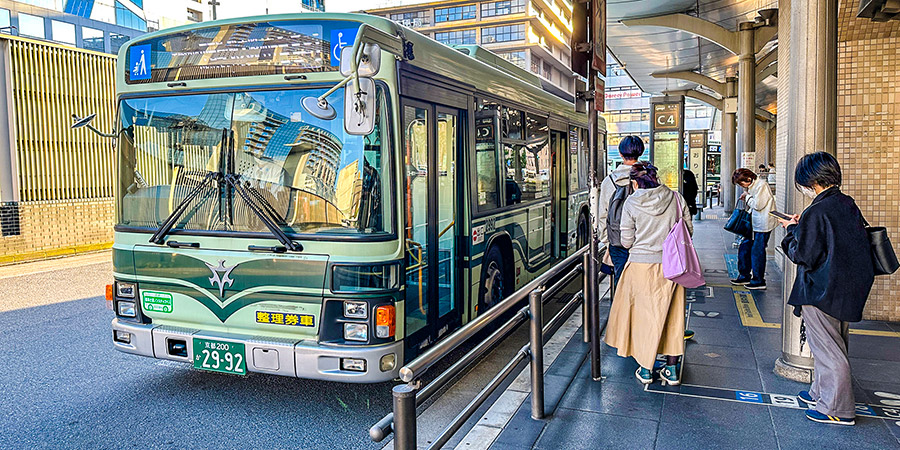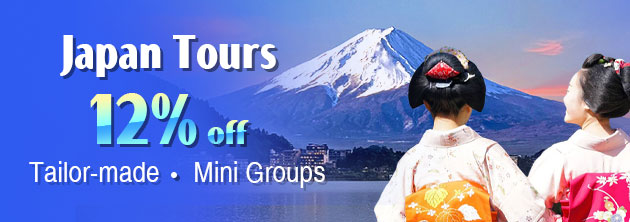How to take local Bus in Kyoto
Kyoto bus system consists of sightseeing buses and fixed routes buses. Sightseeing buses, including Rokuroku lines buses of Kyoto City Bus and Sky Hop Buses, connect attractions directly, thus time-saving. As for fixed route buses, also called local buses, compared with Kyoto’s sightseeing buses they also have advantages like the higher frequency, lower prices, multiple choice, and longer running hours.How Much is it to Take bus in Kyoto?
For most local buses in Kyoto, the fare is 230 yen per ride if your destination is within the flat-fare zone.The flat-fare zone is an area in which the ticket fare per ride is the same, no matter which bus you take or wherever you go. Generally, the zone is like a round with downtown Kyoto as the center. Outside the zone, the bus ticket fare may change depending on the distance you travel. The longer the distance, the higher the fare is.

Kyoto City Bus stop
|
|
Attractions within the flat-fare zone |
|
|
In the west of Kyoto Station |
In the east of Kyoto Station |
|
Toji Temple
Kokedera Temple
Suzumushidera Temple
Nijo Castle
Kinkakuji Temple
Jingoji Temple
Adashino Nenbutsuji Temple
Kitano Tenmangu Shrine
Ryoanji Temple |
Shimogamo Jinja Shrine
Ginkakuji Temple
Eikando Temple
Nanzenji Temple
Heian Shrine
Yasaka Jinja Shrine
Kiyomizu Temple
Tofukuji Temple
Fushimi-Inari Shrine |
|
Attractions outside the flat-fare zone |
|
Kuramadera Temple, Kifune Jinja Shrine, Sanzenin
Temple, and others away from the zone. |
One tip to save money is to buy a 1,100-yen Kyoto Subway and Bus 1-Day Pass, as it supports taking frequently-used local buses timelessly in a day.
What Local buses can I Take in Kyoto?
The buses frequently taken by visitors are Kyoto City Bus, Kyoto Bus, Keihan Bus, and JR Bus. Among them, Kyoto City Bus covers the largest area. You can take it to almost all of Kyoto’s tourist attractions. The other 3 buses run to some areas that Kyoto City Bus does not cover, and you can visit attractions distinctive to those places.1. Traveling in almost whole Kyoto: Kyoto City Bus
Price: mainly 230 yen per rideIdentification color: light green
Operation hours: from 6 a.m. to 10 p.m.
Frequency: no more than 20 minutes
|
Accessible attractions |
Time needed from Kyoto station to destination stops |
|
Nijo Castle |
15 minutes |
|
Gion |
20 minutes |
|
Yasaka Jinja Shrine |
20 minutes |
| Heian Shrine | 30 minutes |
|
Okazaki Park |
30 minutes |
|
Togetsu Bridge |
42 minutes |
| Ginkakuji Temple | 40 minutes |
|
Arashiyama |
42 minutes |
|
Kinkakuji Temple |
41 minutes |
|
Fushimi Inari Shrine |
15 minutes |
|
Kiyomizu Temple |
15 minutes |
|
After arriving at the destination bus stop, you
can get to the tourist attractions mainly within 5 minutes’ walk. |
|
|
|
|
2. Travelling around Kurama, Kifune, or Ohara: Kyoto Bus
Kurama, Kifune, and Ohara are distinctive areas run by Kyoto Bus. In addition, the bus also operates lines between downtown Kyoto and Arashiyama. Generally, the flat-fare areas run by Kyoto Bus are Arashiyama and downtown Kyoto.Identification color: brown
Prices: 230 yen per ride mainly in Arashiyama and downtown Kyoto; additional fees would be charged in Kurama, Kifune, and Ohara
Operation hours: from 7 a.m. to 8 p.m.
Frequency: 25 minutes on average
|
Accessible attractions |
Time needed from Kyoto Station to destination stops |
|
Arashiyama and downtown Kyoto |
|
|
Sanzenin Temple |
70 minutes |
|
Togetsukyo Bridge |
50 minutes |
|
Kokedera Temple |
55 minutes |
|
Suzumushidere Temple |
60 minutes |
|
Tenryuji Temple |
55 minutes |
|
Ohara,
Kurama, and Kibune areas: |
|
|
Attractions |
Time needed from Kokusai-Kaikan Station to
destination stop |
|
Kifune Shrine |
30 minutes |
|
Sanzenin Temple |
25 minutes |
|
Kuramadera Temple |
30 minutes |
3. Travelling around Yamashina: Keihan Bus
Keihan Bus runs around downtown Kyoto and Kyoto Station, along with Yamashina. Yamashina is outside the flat-fare zone.Identification color: red
Prices: 230 per ride in downtown Kyoto and near Kyoto Station, and additional cost is needed in Yamashina.
Operation hours: from 7 a.m. to 9 p.m.
Frequency: from 20 minutes to 45 minutes
|
Accessible attractions |
Time needed from Kyoto Station to destination stop |
|
Daigoji Temple |
30 minutes |
|
Kiyomizudera Temple |
20 minutes |
|
Kajuji Temple |
20 minutes |

Blue JR Bus at Kyoto Station
|
4. An alternative option for Kyoto City Bus to visit Nijo Castel, Kinkakuju Temple, etc: JR Bus
JR Bus in Kyoto operates in the north-west of Kyoto Station. Its running area is covered by that of Kyoto City Bus. JR Bus can also be taken if you want to visit places like Nijo Castle and Kinkakuji Temple when Kyoto City Bus hasn't arrived.
Identification color: bluePrice: 230 yen per ride except for the Shuzan
Operation hours: 6:45 a.m. – 21:20 p.m.
Frequency: 30 minutes on average
|
Accessible attractions |
Time needed from Kyoto Station to the destination
stops |
|
Nijo Castle |
15 minutes |
|
Kitano Tenmangu Shrine |
25 minutes |
|
Royoanji Temple |
30 minutes |
|
Kinkakuji Temple |
30 minutes |
|
Kyoto Aquarium |
10 minutes |
|
Kouzanji Temple |
50 minutes |
|
Ninnaji Temple |
35 minutes |
How to Pay Bus Ticket Fare?
1. Pay the ticket at the front door
2. IC cards, cash, and passes are all supported

Bus front door to exit
|
IC cards:
You can use various IC cards with an “IC” sign, including ICOCA, Kansai One Pass, Suica, PiTaPa, and PASMO.
Please touch your IC card on the card reader once when you get on the bus from the rear door and touch it again before getting off the bus from the front door. Some buses have no card reader near the rear door. This means this bus runs within the flat-fare zone and the fare is 230 yen wherever you go. In this case, you only need to touch your card once before you get off the bus.
Cash:
The buses in Kyoto can’t provide changing service. If you plan to use cash to take a bus, please prepare enough small bills before getting on the bus. There are 2 situations below:1. Destination within flat-fare zone
You only need to pay 230 yen when you get off the bus.
2. Destination outside the flat-fare zone
If your destination is outside the flat-fare zone, you need to take a Seiriken first when you get on the bus. Seiriken is a ticket, on which there is a number. The number symbolizes the stop from which you get on the bus. Before getting off the bus, the digital screen would show many pairs of numbers and fare. Confirm the fare according to the number on your Seiriken, and then put the fare and the Seiriken into the box together.
Supported passes:
Subway and Bus 1-Day Pass supports taking all lines of Kyoto City Bus, and part lines of other buses, including Arashiyama and Ohara areas run by Kyoto Bus timelessly. You can check the exact lines by reading the article: Kyoto Bus Pass.Procedures:
Insert the card into the card slot to print the date when you get off the bus. On that day, the next time you need to take the bus, just show the card with the date printed to the driver before getting off.

